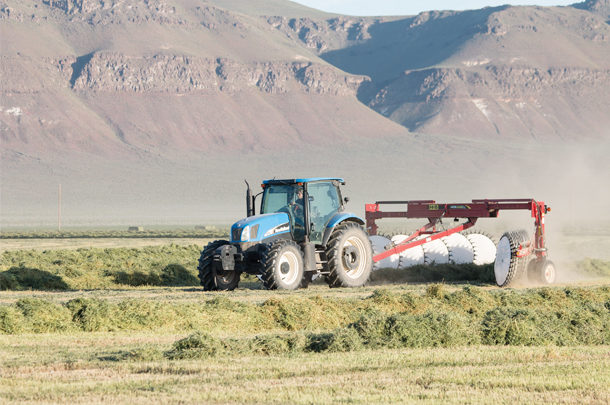Cutting, grazing or sudden hard frost during this period will reduce carbohydrate storage in the crown and roots, which jeopardizes plant survival and production the following season.
There is no such thing as a free lunch, even for alfalfa plants. Perennial plants use energy during their dormant period for metabolism or respiration. Photosynthesis is minimal during dormancy, so energy in the form of storage carbohydrates must be used. Alfalfa stores energy as carbohydrates mostly in the root and crown, but grasses store mostly in the stem bases.
If perennial plants’ carbohydrate storage or bank account is not sufficient, plant tissue will freeze more easily and be more susceptible to pests and diseases. Even in good conditions, alfalfa will use half of its reserves over winter. Growth in the following season will be slower and produce less yield.
Alfalfa has maximum carbohydrate levels at full bloom. That is why I recommend letting the last cutting reach 1/10 bloom, near its peak yield and energy storage, before cutting. Forage quality does not decline in autumn as fast as in hotter periods.
The risk of cutting or grazing in September is that the plants will try to regrow but probably will not reach the point of storage energy necessary for healthy dormancy. I recommend either cutting with enough time for alfalfa to regrow more than 6 inches of height before dormancy, or cutting a couple days after a hard frost, with soil drying to moderate moisture and declining day length.
If timing is right, alfalfa will mostly go dormant after cutting and not try to regrow, thus preserving its energy storage. The trick with an October cutting is to get a good drying window to make hay. Making haylage or baleage at this time of year is an advantage over making dry hay, especially with large rectangular bales.
The fall dormancy rating is important to consider in autumn management. The higher the fall dormancy number, the more alfalfa will regrow with a reduced tendency to become dormant. Thus, higher fall dormant cultivars are more sensitive to management and may be a higher risk of stand loss.
Agronomists in harsh winter environments suggest making sure there is at least 10 inches of growth before dormancy. There is some thermal protection of the crown by leaving that much growth, and snow will not blow off. Because of devastating rodent damage during late fall and winter, I don’t recommend that practice in most moderate climates with rodent problems.
Cutting frequency effects on alfalfa production
In temperate climates, a cutting frequency of 20 days will result in fewer shoots per unit area than 30- or 40-day cutting frequency. A cutting frequency of 20 days will produce less weight per shoot than 30 days, and 30 days will produce less weight per shoot than 40 days. A 20-day cutting frequency may result in loss of about half of the stand, where a 30- or 40-day cutting frequency will usually allow stands to persist.
Carbohydrate reserves in alfalfa are lowest at 20 days after cutting, intermediate at 30 days after cutting and are recovered to pre-harvest levels at 40 days after cutting.
How does this apply to a common cutting interval of 28 days after first cutting? A conceptual model of carbohydrate concentrations in alfalfa roots is shown as affected by a 28- or 42-day cutting schedule (Figure 1).

This model is a synthesis of several studies mostly based on some classical work done in the 1960s by Dale Smith at the University of Wisconsin. Assume alfalfa grows to first bloom and first cutting is taken.
Day zero is defined as the day of first cutting. One portion of the field is cut 28 days later, indicated by the first green arrow and again at 56 days after first cutting (second green arrow). The green line indicates carbohydrate concentrations in roots for this cutting schedule. Another portion is cut at 42 days, indicated by the blue arrow and the resulting carbohydrate concentration in roots by the blue line.
Figure 1 indicates the dynamics of carbohydrate concentrations in alfalfa crowns and roots over time. The result of frequent cutting is much-reduced energy storage. Thus, proper fall management is important for frequent cutting schedules if you want the stand to persist and yield well the following year.
I have observed stands remaining full and productive up to 20 years when there were only one or two cuts per year. I have also observed stands cut with a 28-day interval that lasted only two years and didn’t produce well the second year.
Consider soil fertility and plant nutrition
Late summer and autumn is the best time to apply low-mobility nutrients such as phosphorus and potassium with fertilizer or compost. Sample the soil and get it tested, amend the soil for pH if necessary, then apply nutrients according to recommendations of your state land-grant university fertility guide.
Choose the nutrient source based primarily on the lowest cost per pound of plant available nutrient. Generally, it will be less expensive as manure, compost or triple super phosphate, with ammonium phosphate as the most costly per unit.
Don’t become complacent with fall management; it is the most critical time of the season for alfalfa management with greater influence on next cropping season than many producers previously thought. ![]()
Glenn Shewmaker is an extension forage specialist with University of Idaho. Email Glenn Shewmaker.
PHOTO: Fall alfalfa cutting management is critical for the following season’s success. If timing is right, alfalfa will mostly go dormant after cutting and not try to regrow, thus preserving its energy storage. Photo by Lynn Jaynes.











